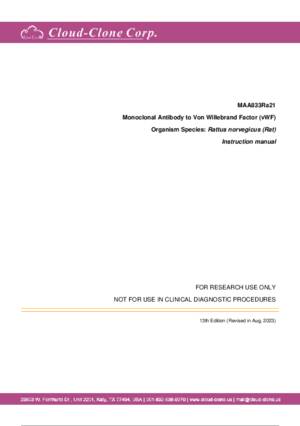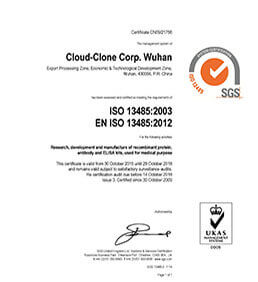Monoclonal Antibody to Von Willebrand Factor (vWF)
F8VWF; VWD; von Willebrand antigen 2
- Product No.MAA833Ra21
- Organism SpeciesRattus norvegicus (Rat) Same name, Different species.
- SourceMonoclonal antibody preparation
- HostMouse
- Potency (Clone Number)C1
- Ig Isotype IgG2a Kappa
- PurificationProtein A + Protein G affinity chromatography
- LabelNone
- Immunogen RPA833Ra01-Recombinant Von Willebrand Factor (vWF)
- Buffer Formulation0.01M PBS, pH7.4, containing 0.05% Proclin-300, 50% glycerol.
- TraitsLiquid
- Concentration1mg/mL
- Organism Species MoreHomo sapiens (Human)
- ApplicationsWB
If the antibody is used in flow cytometry, please check FCM antibodies. - DownloadInstruction Manual
- UOM 20µl100µl 200µl 1ml 10ml
- FOB
US$ 109
US$ 253
US$ 362
US$ 905
US$ 3620
For more details, please contact local distributors!
SPECIFITY
The antibody is a mouse monoclonal antibody raised against vWF. It has been selected for its ability to recognize vWF in immunohistochemical staining and western blotting.
USAGE
Western blotting: 0.01-3µg/mL;
Optimal working dilutions must be determined by end user.
STORAGE
Store at 4°C for frequent use. Stored at -20°C in a manual defrost freezer for two year without detectable loss of activity. Avoid repeated freeze-thaw cycles.
STABILITY
The thermal stability is described by the loss rate. The loss rate was determined by accelerated thermal degradation test, that is, incubate the protein at 37°C for 48h, and no obvious degradation and precipitation were observed. The loss rate is less than 5% within the expiration date under appropriate storage condition.
GIVEAWAYS
INCREMENT SERVICES
-
 Antibody Labeling Customized Service
Antibody Labeling Customized Service
-
 Protein A/G Purification Column
Protein A/G Purification Column
-
 Staining Solution for Cells and Tissue
Staining Solution for Cells and Tissue
-
 Positive Control for Antibody
Positive Control for Antibody
-
 Tissue/Sections Customized Service
Tissue/Sections Customized Service
-
 Phosphorylated Antibody Customized Service
Phosphorylated Antibody Customized Service
-
 Western Blot (WB) Experiment Service
Western Blot (WB) Experiment Service
-
 Immunohistochemistry (IHC) Experiment Service
Immunohistochemistry (IHC) Experiment Service
-
 Immunocytochemistry (ICC) Experiment Service
Immunocytochemistry (ICC) Experiment Service
-
 Flow Cytometry (FCM) Experiment Service
Flow Cytometry (FCM) Experiment Service
-
 Immunoprecipitation (IP) Experiment Service
Immunoprecipitation (IP) Experiment Service
-
 Immunofluorescence (IF) Experiment Service
Immunofluorescence (IF) Experiment Service
-
 Buffer
Buffer
-
 DAB Chromogen Kit
DAB Chromogen Kit
-
 SABC Kit
SABC Kit
-
 Long-arm Biotin Labeling Kit
Long-arm Biotin Labeling Kit
-
 Real Time PCR Experimental Service
Real Time PCR Experimental Service
| Magazine | Citations |
| Int J Nanomedicine. | Amorphous silica nanoparticles impair vascular homeostasis and induce systemic inflammation Pubmed:Pmc4047982 |
| Inflammation.? | Systemic and Flap Inflammatory Response Associates with Thrombosis in Flap Venous Crisis Pubmed:25448261 |
| Cellular Physiology and Biochemistry | Short-Term Nose-Only Water-Pipe (Shisha) Smoking Exposure Accelerates Coagulation and Causes Cardiac Inflammation and Oxidative Stress in Mice Pubmed:25634761 |
| Asian Pac J Trop Med | Blood pH in coronary artery microthrombosis of rats PubMed: 26522304 |
| Chemical Research in Toxicology | Subchronic Toxicity and Cardiovascular Responses in Spontaneously Hypertensive Rats after Exposure to Multiwalled Carbon Nanotubes by Intratracheal Instillation PubMed: 25580880 |
| Sci Rep. | Differential integrative omic analysis for mechanism insights and biomarker discovery of abnormal Savda syndrome and its unique Munziq prescription Pubmed:27296761 |
| American Journal of Reproductive Immunology | Circulating endothelial cells, circulating endothelial progenitor cells, and von Willebrand factor in pregnancies complicated by hypertensive disorders doi:10.1111 |
| Shock | Low-Dose Sodium Nitrite Fluid Resuscitation Prevents Lethality From Crush Syndrome by Improving Nitric Oxide Consumption and Preventing Myoglobin Cytotoxicity in Kidney in A Rat Model. pubmed:27941593 |
| Regenerative Biomaterials | The directional migration and differentiation of mesenchymal stem cells toward vascular endothelial cells stimulated by biphasic calcium phosphate ceramic 10.1093/rb/rbx028 |
| Acta Anaesthesiologica Scandinavica | Early prognostic factors in septic shock cancer patients: a prospective study with a proteomic approach Pubmed:29315472 |
| Gynecologic and obstetric investigation | Relationship between the von Willebrand Factor Plasma Concentration and Ultrasonographic Doppler Findings in Pregnancies Complicated by Hypertensive … Pubmed:29621786 |
| Biological Trace Element Research | Role of Pigment Epithelium-Derived Factor in Arsenic-Induced Vascular Endothelial Dysfunction in a Rat Model Pubmed: 30392020 |
| Experimental and Therapeutic Medicine | Risk stratification and prognostic evaluation of endothelial cell‑specific molecule1, von Willebrand factor, and a disintegrin‑like and metalloprotease with … |
| Scientific Reports | Association between Upper-airway Surgery and Ameliorative Risk Markers of endothelial function in obstructive Sleep Apnea Pubmed: 31882827 |
| International Journal of Molecular Sciences | Waterpipe Tobacco Smoke Inhalation Triggers Thrombogenicity, Cardiac Inflammation and Oxidative Stress in Mice: Effects of Flavouring Pubmed: 32075078 |
| environmental research | Pigment epithelium-derived factor (PEDF) ameliorates arsenic-induced vascular endothelial dysfunction in rats and toxicity in endothelial EA. hy926 cells Pubmed: 32315827 |
| evidence-based complementary and alternative medicine | Xiaoyukang Jiaonang Promotes the Degradation of Hypoxia-Inducible Factor 1α and Antiangiogenesis and Anti-Inflammation in Chronic Subdural Hematoma … Pubmed: 32228124 |
| Indian Journal of Public Health Research & Development | Enhanced Fibrin-Lysis in Grade-1 Dengue Haemorrhagic Fever |
| Ad hatoda Vasica: a potential ayurvedic intervention against COVID-19 associated impaired immune response and hypoxia-inflammation phenotype | |
| Radiat Res | Investigating the Multi-Faceted Nature of Radiation-Induced Coagulopathies in a G?ttingen Minipig Model of Hematopoietic Acute Radiation Syndrome 34019667 |
| Intensive Care Medicine Experimental | Preservation of renal endothelial integrity and reduction of renal edema by aprotinin does not preserve renal perfusion and function following experimental … 34169407 |
| Experimental and Therapeutic Medicine | Salvianolic acid B improves the survival rate, acute kidney dysfunction, inflammation and NETosis‑mediated antibacterial action in a crush syndrome rat model Pubmed:35386617 |







